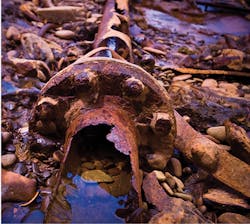Air Valves for Drinking Water Systems?
Check your pipe breaks!
Air valves are an essential component of any wastewater system as the cycling of pumps creates the need to constantly introduce air into the system as well as discharge it as demand requires. But many municipalities don’t think that drinking water systems require air valves since they don’t see the pump cycles that their wastewater counterparts experience.
This is not true. Some amount of air is always present in any water column. And that air is constantly being dissolved and released with changes in pressure and temperature. Once released, it travels the pipeline until it comes to a high spot where all the bubbles combine to create pockets, which can become stationary in the pipeline, growing larger and larger over time.
A.R.I. helps municipalities mitigate the harmful effects of air pockets in pipes.
These pockets cause restrictions in the pipeline that reduce flow and increase inefficiencies through head loss. They also create the potential for catastrophic damage during system conditions such as vacuum, water column separation, and other types of transient events. These air pockets are also a source of corrosion.
When air in your system multiplies the effects of surge events it often finds the weakest link in your pipeline to release the energy. Many times, these breaks are in locations with corroded pipes. Pipes that might have lasted 5 or 10 more years at normal working pressures succumb to the multiplied effects of the surge event — which can be 10 times the normal working pressures or more.
A.R.I. USA specializes in helping educate municipal and industrial pipeline designers on the effects of air and how to best deal with it. WW
A.R.I. USA is exhibiting at AWWA’s ACE18 expo in booth 20052. Learn more at ariusa.com.
Circle No. 295 on Reader Service Card

